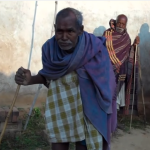Women of Keshavpur village, Uttar Pradesh had been denied work under NREGA (National Rural Employment Guarantee Act) for two years because of the patriarchal views of the authorities of the region. Under NREGA, every member of rural India, who demands work has the right to get work. However, the employment office of Bhadohi district, where Keshavpur is situated, had repeatedly turned the women of the village back for two years under the pretext, "You are women, you can't toil as much as men can," This attitude is perhaps reflected in the statistics that show women's participation in NREGA. Uttar Pradesh has the lowest percentage of women participating in NREGA in the country at 24 percent while the national average is almost at 55 percent.
When Video Volunteers correspondent Kesha Devi heard about this gender-based discrimination, she was determined to end it and get the women their right to work. But her road to revolution was not easy. The women were scared of the government officials, who had also tried deterring Kesha's initiative. "While I was documenting the women's problem here, the employment officers clearly told me not to get signatures of these women on the application seeking employment, neither should any papers be sent anywhere," recalls Kesha. In the end, though, her persistence won. She went back to the women after two days, patiently told them their rights and through Video Volunteers' impact videos, she made them realise how change is possible if a community demands its rights as one.
Ready to put up a fight for their rights, the women signed the application seeking work and agreed to make the video. The women, almost 20-25 of them joined Kesha and presented the letter to Gram Sevak, the village representative. Within a month, the Programme Officer called the women to give them work.
Women are entitled to equal wages in MGNREGA, a key step towards gender empowerment. The women's participation in NREGA has seen almost 55 percent in 2014-15, the highest rate of employment since the scheme's inception, a stark difference from overall women's participation in the country's workforce, which stands at a poor 28.7 percent. If the workforce participation rate for women in India was the same as for men, roughly 217 million women would join the labour force.
At 53 percent, India has one of the worst gender gaps ( a disproportionate difference between the sexes) in the world when it comes to labour force participation. Not only other countries such as Bangladesh, Sri Lanka and Pakistan in the BRICS grouping but also emerging economies in Asia such as Indonesia fare much better when it comes to employing women. The reasons for lower participation can be attributed to a plethora of reasons - ranging from pressures and prejudice of patriarchal society to gender-based discrimination in wages and finally lack of safety and supporting infrastructure for women to confidently pursue their right to employment. However, this Video Volunteers' impact and many other such impacts show that change is possible, one video at a time.
This video was made by a Video Volunteers Community Correspondent Kesha Devi.
Community Correspondents come from marginalized communities in India and produce videos on unreported stories. These stories are ’news by those who live it.’ They give the hyperlocal context to global human rights and development challenges. See more such videos at www.videovolunteers.org. Take action for a more just global media by sharing their videos and joining in their call for change.
The Student Teacher Ratio and School Area needs improvement
In this video of UPS Manwan Awoora school, Kupwara, Kashmir, the community correspondent Pir Azhar shows us that there are nine classes for 250 students, and due to lack of space, the lower primary classes are held outside in the open. Also the school has only 7 teachers.

